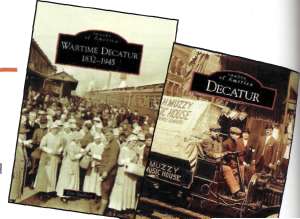 |
Home | Search | Browse | About IPO | Staff | Links |
 |
Home | Search | Browse | About IPO | Staff | Links |

 Wartime Decatur: 1832-1945 and Decatur By Brent Wielt Dan Guillory's two new pictorial histories join a long list of local history books about Decatur and Macon County. Looking back over all these titles you'd expect there is nothing new to discover. Happily, such is not the case. For a small city, Decatur is rich with history. Through the efforts of the Macon County Historical Society, the Decatur Genealogical Society, the Decatur Public Library, local newspapers, private collectors, and others, a significant part of the heritage of Decatur has been preserved. Guillory's books give readers yet another look into these archives and collections, and new stories emerge that even lifelong residents probably don't know. Sergeant Castle Williams, for example, a hero of the First World War, probably would have been lost to time if not for the author's discovery in "Wartime Decatur." Williams' remarkable story, though commonly known to Decaturites a few generations ago, has faded from the collective memory. Now it can be retold to a new generation and re-remembered. Both books bring up questions about how Decatur arrived at where it is today. To know present-day Decatur and see its past through these images is amazing and sad. Amazing in the electric sense—walking the same streets as did Abraham Lincoln and Governor Richard J. Oglesby for example; sad in that much of the architectural and natural landscapes have been transformed or destroyed. The city's old smokestacks, which meant blue-collar jobs and prosperity (and backbreaking labor and pollution), are mostly gone as are the cherished churches, schools, public buildings, and family homes. Fires, tornadoes, development, dramatic shifts in the economy, and the ravages of time have changed the face of Decatur, but not always for the better. Guillory's books make us think about Decatur today, and its future tomorrows. Perhaps another generation won't be so quick to make the same flawed decisions; perhaps it will learn from the example of our past urban blunders. Civic pride and tough decisions about a citizen's responsibility abound in each page. Decatur still suffers from the loss of many of its most visible architectural gems and historic sites. The Carnegie public library, the Millikin Bank, and other lost landmarks remain sore spots with many Decaturites. These photographs are our only connection to that bit of the past. Although several images are included in most Decatur histories, Guillory makes note of the losses for future generations and leaves readers pondering what might have been had they survived. Guillory's captions further illuminate these photographs. In addition to the stock portraits are casual family snapshots, interpreted with a poet's heart and a cultural historian's eyes— observations not always found in the other kinds of histories. And when there are gaps in the photographic record, Guillory fills them with postcards, business trade cards, and other archival images that add to the diverse character of the books. Another strength of these titles is the social history they reflect. The portraits of the tired Decatur rail-yard worker and the smiling telephone operators tell of a much larger America. Guillory chose the photographs for each book, and his selections and captions instruct readers, helping them better understand the subjects in the context of their time. It isn't epic history, but it has its drama, humor, and tragedy. If there is any criticism of these books it is their format. Arcadia Publishing confines its authors to a certain number of pages and a rigid design; though the individual books are attractive, their design makes them virtually indistinguishable from the hundreds of Arcadia titles already in print. It's a minor complaint. Such cookie-cutter publishing keeps the price within reason, about half what you'd pay for a coffee-table pictorial history. Both books have little content after 1945. The stories of Korean, Vietnam, and Gulf War veterans, as well as the boom and bust years in the second half of the twentieth century in Decatur offer plenty of material for future historians to contemplate. But these two books cover the first hundred-plus years of life in Decatur nicely. Beyond any limitations or criticisms, these pictorial history books help Decatur preserve its past, think about its future, and celebrate the efforts of all those who work on behalf of local history. Brent Wielt is Historic Sites Manager at the Macon County Conservation District Decatur. 24 Illinois Heritage |
|
|